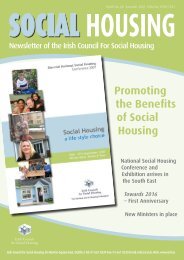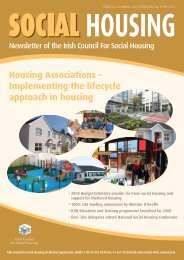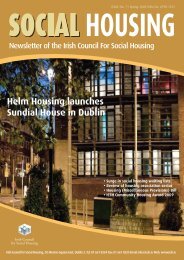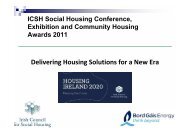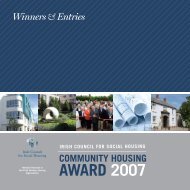National Housing Strategy for People with a Disability 2011 - 2016
National Housing Strategy for People with a Disability 2011 - 2016
National Housing Strategy for People with a Disability 2011 - 2016
Create successful ePaper yourself
Turn your PDF publications into a flip-book with our unique Google optimized e-Paper software.
10.4 The data shows that the majority of adults <strong>with</strong> intellectual disabilities live in homesettings (49%), <strong>with</strong> significant numbers also living in community group homes (21%) andresidential settings (23%). In 2009, 330 people <strong>with</strong> an intellectual disability resided fulltime in mental health service facilities, either in psychiatric hospitals (277 individuals) or inmental health community residences (53 individuals).Transition from Institutional to Community Based Living10.5 Deinstitutionalisation refers to the move away from housing people <strong>with</strong> disabilities inresidential institutions, where all services were generally provided on site, to communitybasedsettings. Large residential institutions, while maximising the pooling of supportservices, segregate residents from the community and from normal social life. Research hasdemonstrated that such institutions are not able to deliver the same quality of life <strong>for</strong> theirresidents as community based alternatives 101 . Additional in<strong>for</strong>mation in relation toresidential services <strong>for</strong> people <strong>with</strong> disabilities is contained in Appendix 10.10.6 Extensive international research, spanning over thirty years, consistently pointspredominantly towards a better quality of life <strong>for</strong> people <strong>with</strong> disabilities in communitysettings compared to living in institutional care. In 2009, the NDA published a review ofexisting research comparing dispersed and clustered community housing <strong>for</strong> disabled adultswhich found that “dispersed housing appears to be superior to clustered housing on themajority of quality indicators studied” 102 . It should be noted that the review alsodifferentiates between village communities 103 and other types of clustered settings andhighlights that the village communities model has some benefits <strong>for</strong> people <strong>with</strong> less severedisabilities 104 . The review concludes that although this model is an important part of serviceprovision, it is not one which can be feasibly provided <strong>for</strong> everyone.HSE Working Group on Congregated Settings10.7 A high level national steering group was established by the HSE in 2007 to developproposals to deliver community based, person-centred responses <strong>for</strong> people living incongregated settings. Membership of this group included the Department of Health,Inclusion Ireland, representatives of service providers, <strong>Disability</strong> Federation of Ireland andthe <strong>National</strong> <strong>Disability</strong> Authority.101Included in Society - Results and Recommendations of the European Research Initiative on Community-BasedResidential Alternatives <strong>for</strong> Disabled <strong>People</strong>, European Commission, 2003.102Mansell, J and Beadle-Brown, J, 2009, Dispersed or Clustered <strong>Housing</strong> <strong>for</strong> Disabled Adults: a systematic review.103This model involves carers/volunteers living and working along <strong>with</strong> residents <strong>with</strong> a disability.104In the physical well-being domain, clustered settings have been found to be superior in hours of recreationalactivity, contact <strong>with</strong> dentists, psychiatrists and psychologists, some health screening, some aspects of safety,contact <strong>with</strong> family and friends, visitors to the home and satisfaction <strong>with</strong> relationships. However, in many ofthese cases the better results refer only to village communities and not to campus housing or clusteredhousing. (Mansell, J and Beadle-Brown, J, 2009, Dispersed or Clustered <strong>Housing</strong> <strong>for</strong> Disabled Adults: asystematic review)125125



